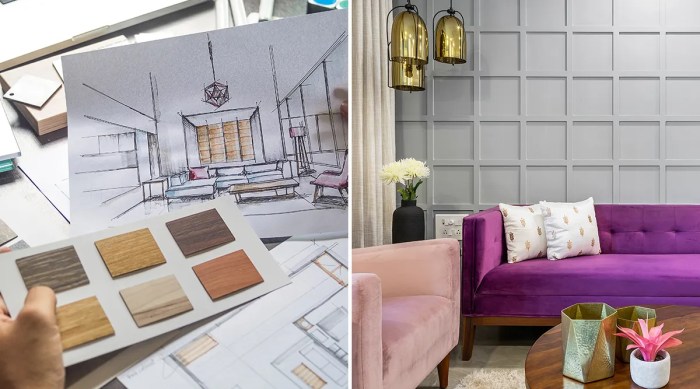Crafting Spaces: Exploring the World of an Architect and Interior Designer

As architect and interior designer take center stage, this opening passage beckons readers into a world crafted with good knowledge, ensuring a reading experience that is both absorbing and distinctly original.
Delve into the realm where creativity meets functionality, where spaces are transformed into works of art that breathe life into buildings and homes alike.
Role of an Architect and Interior Designer

Architects and interior designers play crucial roles in the design and construction of buildings, but they have distinct responsibilities that contribute to the overall success of a project.
Primary Responsibilities
- Architects are responsible for designing the overall structure of a building, considering factors such as functionality, safety, and aesthetics.
- Interior designers focus on creating functional and aesthetically pleasing interior spaces, including selecting color schemes, furniture, and decor.
Differences in the Design Process
- Architects primarily work on the external aspects of a building, including its shape, structure, and overall design concept.
- Interior designers focus on the internal spaces, ensuring that they are both visually appealing and functional for the occupants.
Collaboration in Projects
Effective collaboration between architects and interior designers can be seen in projects such as modern office buildings, where the architect's vision for the exterior is seamlessly integrated with the interior designer's expertise in creating productive workspaces.
Education and Training

When it comes to the education and training required for architects and interior designers, there are some distinct differences in their typical backgrounds and training programs.
Architects
Architects typically need to complete a professional degree in architecture from an accredited program. This could be a Bachelor's or Master's degree in Architecture. After completing their degree, aspiring architects must also complete a period of practical training or internship, usually lasting around 3 years.
Finally, architects must pass the Architect Registration Examination (ARE) to become licensed.
Interior Designers
On the other hand, interior designers usually pursue a Bachelor's degree in Interior Design or a related field. Some interior designers also opt for an Associate's degree or a certificate program in Interior Design. While licensure is not always required for interior designers, many states do have regulations in place.
Interior designers may also choose to become certified through organizations like the National Council for Interior Design Qualification (NCIDQ).
Training Programs Comparison
The training programs for architects and interior designers differ mainly in the focus of their education. Architects learn about building design, construction, structural systems, and building codes. They also study architectural history and theory. Interior designers, on the other hand, focus more on interior spaces, materials, color theory, furniture design, and spatial planning.
Both professions require a strong foundation in design principles and the ability to use design software.
Importance of Continuous Learning
Continuous learning and skill development are crucial in the fields of architecture and interior design. With rapidly evolving trends, technologies, and building materials, professionals in these fields must stay updated with the latest advancements. Continuing education courses, workshops, conferences, and networking events help architects and interior designers expand their knowledge, improve their skills, and stay competitive in the industry.
Design Process
The design process for architects and interior designers involves several crucial steps that are essential for creating functional and aesthetically pleasing spaces.
Concept Development
Concept development is a key phase in the design process for both architects and interior designers. Architects typically focus on the overall structure and form of a building, taking into account factors such as site conditions, building codes, and client requirements.
Interior designers, on the other hand, concentrate on the interior spaces, including layout, materials, colors, and furnishings. They work closely with clients to understand their needs and preferences to develop a design concept that meets their expectations.
Space Planning
Space planning is another critical aspect of the design process for architects and interior designers. Architects are responsible for creating efficient and functional layouts that meet the needs of the building's occupants. They consider circulation patterns, zoning regulations, and spatial relationships to optimize the use of space.
Interior designers focus on arranging furniture, fixtures, and equipment within interior spaces to enhance functionality and flow. They pay attention to details such as traffic flow, ergonomics, and accessibility to create user-friendly environments.
Integrating Aesthetics with Functionality
One of the challenges for architects and interior designers is to seamlessly integrate aesthetics with functionality in their designs. Architects strive to create buildings that are not only visually appealing but also structurally sound and sustainable. They consider factors such as form, scale, proportion, and materials to achieve a harmonious design.
Interior designers aim to balance aesthetics with functionality by selecting furnishings, finishes, and decorative elements that enhance the overall look and feel of a space while meeting the practical needs of the users. They focus on creating environments that are both beautiful and livable, striking a perfect balance between style and functionality.
Tools and Technologies
Architects and interior designers rely on a variety of tools and software to bring their designs to life and streamline the design process.
Essential Tools and Software
- Computer-Aided Design (CAD) Software: Programs like AutoCAD and SketchUp allow architects and interior designers to create detailed 2D and 3D models of their designs.
- Building Information Modeling (BIM) Software: BIM tools such as Revit help professionals design and manage building projects collaboratively.
- Virtual Reality (VR) and Augmented Reality (AR) Tools: VR and AR technologies enable clients to experience designs in a more immersive way before construction begins.
- Project Management Software: Tools like Trello and Asana help architects and designers stay organized and manage project timelines efficiently.
- Lighting Design Software: Programs like Dialux assist in simulating and planning lighting schemes for interior spaces.
How Technology Influences the Design Process
Technology has significantly impacted the design process in both architecture and interior design by enhancing collaboration, visualization, and efficiency. CAD and BIM software allow for more accurate and detailed designs, while VR and AR tools provide a realistic preview of the final space.
Project management software helps streamline communication and project tracking, improving overall project outcomes.
Innovative Technologies in Architecture and Interior Design
- 3D Printing: Architects and designers can create physical models and prototypes quickly and cost-effectively using 3D printing technology.
- Artificial Intelligence (AI): AI algorithms can analyze data to optimize building designs for factors like energy efficiency and sustainability.
- Smart Home Technology: Integration of smart devices and IoT (Internet of Things) in interior design allows for automation and control of various home systems.
- Sustainable Design Tools: Software like Ecotect and Green Building Studio help professionals design environmentally friendly buildings and spaces.
Collaboration and Communication
Effective collaboration between architects and interior designers is crucial for the success of any project. By combining their expertise, creativity, and vision, they can create spaces that are not only aesthetically pleasing but also functional and practical.
Importance of Collaboration
Collaboration between architects and interior designers allows for a holistic approach to design, considering both the structural elements and the interior aesthetics of a space. This ensures that the final result is cohesive and harmonious, with seamless transitions between the exterior and interior.
- Enhanced creativity: By working together, architects and interior designers can bounce ideas off each other and come up with innovative solutions that may not have been possible individually.
- Optimized functionality: Architects focus on the structural aspects of a building, while interior designers consider how the space will be used. By collaborating, they can create spaces that not only look good but also serve their intended purpose efficiently.
- Improved problem-solving: Collaboration allows for a more comprehensive analysis of potential challenges and the development of effective solutions that take into account both the form and function of a space.
Effective Communication for Project Outcomes
Clear and open communication is essential for ensuring that the vision for a project is accurately conveyed and executed. It helps in avoiding misunderstandings, delays, and costly mistakes that can arise when there is a lack of communication between architects and interior designers.
- Regular meetings: Schedule regular meetings to discuss project progress, share updates, and address any issues that may arise. This ensures that everyone is on the same page and working towards a common goal.
- Use of visual aids: Visual aids such as sketches, renderings, and mood boards can help in conveying ideas and concepts more effectively, allowing for better understanding and alignment between architects and interior designers.
- Establishing a clear communication protocol: Define roles, responsibilities, and expectations from the beginning to avoid confusion later on. Having a structured communication plan in place can streamline the decision-making process and facilitate smooth project execution.
Tips for Fostering a Productive Working Relationship
Building a strong working relationship between architects and interior designers is essential for the success of a project. Here are some tips to foster a productive collaboration:
- Respect each other's expertise: Recognize and appreciate the unique skills and knowledge that architects and interior designers bring to the table. Valuing each other's contributions can lead to a more harmonious working relationship.
- Be open to feedback: Constructive feedback is essential for growth and improvement. Encourage open and honest communication, and be willing to listen to and consider each other's perspectives and suggestions.
- Collaborate from the start: Involve both architects and interior designers in the early stages of a project to ensure that the design process is holistic and integrated. This allows for a more cohesive and coordinated approach to creating spaces that meet both aesthetic and functional requirements.
Closing Summary
In conclusion, the dynamic collaboration between architects and interior designers results in spaces that are not just visually stunning but also perfectly functional, showcasing the harmonious blend of creativity and practicality. Dive into this fascinating world and witness how these professionals shape the way we live, work, and interact with our surroundings.
FAQs
What are the primary responsibilities of an architect and an interior designer?
Architects focus on the overall structure and design of buildings, while interior designers specialize in creating functional and aesthetically pleasing interior spaces.
What is the typical educational background required for architects and interior designers?
Architects usually need a professional degree in architecture, while interior designers may have a degree in interior design or a related field.
How do architects and interior designers approach concept development differently?
Architects tend to focus more on the external structure and functionality, while interior designers prioritize the interior layout, furniture, and decor.
What essential tools and software are used by architects and interior designers?
Architects often use software like AutoCAD and Revit, while interior designers may use tools like SketchUp and Adobe Photoshop for design purposes.
Why is collaboration between architects and interior designers important?
Collaboration ensures that the overall design of a space seamlessly integrates both the structural and interior elements, resulting in a cohesive and well-designed environment.




